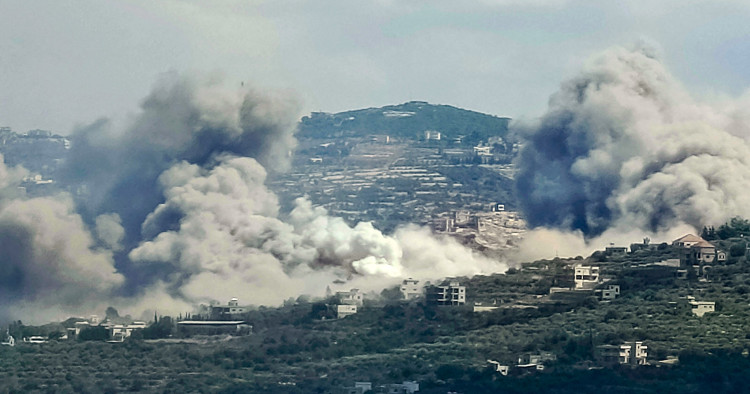
Following a series of brazen attacks against Iran-backed Hezbollah last week that decimated the Lebanese militant group’s command-and-control structure — an operation widely believed to have been executed by Israel — the two hostile parties have been trading some of the most severe fire since Oct. 7. With tensions ablaze, on Sept. 22, Hezbollah struck deep into Israel, firing retaliatory drones, rockets, and missiles at the Ramat David Airbase as part of its “open-ended battle of reckoning.” While most of these munitions were intercepted, the region is bracing for an all-out war with potentially devastating consequences for Lebanon. And as the Israeli side ups the ante with an expanding air campaign, Hezbollah shows no signs of backing down; speculation abounds about how the situation will evolve and especially how Tehran will respond.
The deadly, back-to-back pager/two-way radio attacks against Hezbollah, which killed dozens and wounded thousands of its operatives, undoubtedly signaled a new phase in the intense cross-border exchanges between the group and Israel. In recent weeks, the Israeli military has been moving its elite forces to the north, while Israeli Prime Minister Benjamin Netanyahu has been heightening his rhetoric; on Sunday, he vowed to take “whatever action necessary” to eliminate the threat posed by Hezbollah rockets and artillery barrages, with an eye to ultimately restoring calm along the border with Lebanon and enabling Israelis to return to their abandoned homes in northern Israel. Defense Minister Yoav Gallant made similar statements, days earlier threatening to pursue enemies “even in Dahieh,” a suburb of Beirut. Although weakened by the special operations and airstrikes targeting its members and top commanders, Hezbollah, in turn, has vowed to continue striking at Israel until a cease-fire in Gaza is reached. This has raised fears that both the United States (Israel’s closest ally) and Iran (Hezbollah’s patron) may be drawn into a regional war.
Yet in Iran, there is less appetite for a regional conflagration that directly pits it against Israel. To date, Tehran has largely sought to avoid such an open confrontation by playing a deterrence game with the Israeli side. Even its attack on Israel in April was for show: highly choreographed to cause as little damage as possible. Central to this strategy, which has relied on asymmetric warfare against Israel, has been Hezbollah, allowing Iran to engage in battle while maintaining plausible deniability. But given the risks of wider escalation posed by the latest phase of deadly Israeli strikes on Hezbollah, Iran will likely want to keep things “under control”; so any retaliatory action taken by its Lebanese proxy is unlikely to be anything other than symbolic. Will Hezbollah and Iran’s response be tactical or strategic?
A tactical reaction would be sufficiently constrained so as not to push Israel toward engaging in an uncontrollable war in Lebanon. The Iranian regime’s calculation would be that a sharp escalation and spillover from the conflict in Gaza could negatively affect US Vice President Kamala Harris’ presidential campaign and contribute to a Donald Trump victory, whose administration might choose to concentrate on destroying Iran’s nuclear capabilities. A strategic response, on the other hand, would take the form of a noticeable hardening of Tehran’s foreign policy positions — in particular, the open pursuit of nuclear weapons, in a reversal of the oft-repeated assertion by Iranian high-ranking officials that the country does not seek to pursue weapons that are banned by religious fatwa. The current line of thinking in Iran, however, seems to be a desire to delay the confrontation and opt for a limited response — and here, Tehran’s interests are aligned with Hezbollah’s.
Despite Hezbollah leader Hassan Nasrallah’s threats of retribution and punishment for the pager/two-way radio explosions and subsequent airstrikes targeting top Hezbollah commanders Ibrahim Akil and Ali Karaki, the group is similarly keen on avoiding war with Israel. The attacks were a significant blow to Hezbollah’s image, sense of internal security, and readiness for war; and they demonstrated that it cannot compete with Israel’s capabilities and reach. But Hezbollah is in a bind. On the one hand, its credibility is at stake and its base is fuming, so it will need to carry out a decisive response. On the other, given its recent losses and the deficiencies of its military arsenal, it likely prefers a controlled response that settles the situation enough to be able to return to low-level warfare conducted within careful parameters. At the same time, in this new phase of war in which Israel is pivoting to an aggressively pursued military solution, Hezbollah will want to delay as long as possible one potential outcome of the current standoff: the militant group’s complete destruction.
While its goals and considerations are presently in concert with Iran, Hezbollah’s leadership is contending with mounting calls for a response that demonstrates an ability to cause harm to Israel. The group needs to show force — as it did over the weekend by attacking Haifa — but its public is asking for blood. Hezbollah and its backers are nevertheless not likely to escalate the prevailing cycle of violence unless Israel undertakes yet another assault that causes widespread bloodshed. Until then, Hezbollah will presumably navigate the current situation with an eye to easing the passions of its base.
